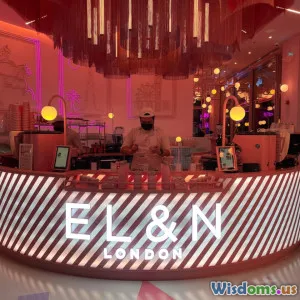
What Designers Can Learn from Failed Branding Projects
8 min read Discover crucial lessons from failed branding projects to elevate your design strategy and avoid common pitfalls in graphic design. (0 Reviews)
What Designers Can Learn from Failed Branding Projects
Introduction
In the vibrant world of graphic design, branding is more than just creating a logo—it’s about telling a compelling story, building trust, and connecting emotionally with an audience. Yet, not every branding journey ends in triumph. Some projects falter, leaving brands vulnerable and designers perplexed. But amid these setbacks lie invaluable insights for designers willing to dissect the anatomy of failure. What can failed branding projects teach us about creativity, process, and execution? This article dives deep into the lessons these projects offer, transforming mistakes into catalysts for innovation and growth.
Understanding Branding Failures: More Than Just Visuals
Before uncovering specific lessons, it’s essential to recognize that branding failure isn't solely about aesthetic missteps. While poor design choices may be visible manifestations, the roots often run much deeper—including misaligned strategy, misunderstanding the market, or failing to communicate a brand’s value proposition effectively.
For instance, the infamous 2012 Tropicana packaging redesign led to a 20% drop in sales in two months. The problem? Customers couldn’t recognize their familiar product on shelves—a clear case where visual overhaul overlooked consumer connection and brand equity.
This example illustrates that branding is an ecosystem balancing design, messaging, and psychology. Successful brands harmonize these elements, while failures reveal where that balance is broken.
1. Lesson One: Research is Non-Negotiable
A profound takeaway from many failed branding projects is the critical role of thorough research. Designers must delve into market trends, customer insights, competitive landscapes, and cultural nuances before putting pen to paper.
Case Example: Gap’s 2010 Logo Redesign
Gap’s attempt to revamp its classic logo into a minimalist blue box sparked significant backlash. The company underestimated consumer attachment to the existing emblem. Customers voiced their displeasure online fiercely, forcing a quick reversal.
The root cause: a lack of engagement with the customer base and insufficient research on brand loyalty and expectations.
Actionable Insight
- Conduct qualitative and quantitative research including surveys, interviews, and competitor analyses.
- Don’t skip testing preliminary concepts with actual users.
- Respect emotional connections customers have with existing branding elements.
2. Embrace Clarity Over Complexity
Often designers fall into the trap of complexity—aiming for trendy, intricate concepts that ultimately confuse the audience. Failed projects highlight the power of conveying a clear, simple message.
Real-World Example: Airbnb’s 2014 Rebrand
Airbnb’s “Bélo” symbol initially puzzled many users due to its abstractness. While the mark achieved symbolic meanings of belonging and connection, the rollout lacked clear storytelling, making the brand message ambiguous.
Over time, Airbnb supplemented the visuals with strong narrative elements and consistent use, emphasizing clarity and emotional resonance to cement its identity.
Takeaway for Designers
- Prioritize straightforwardness aligned with brand values.
- Avoid relying on abstract symbolism without context.
- Utilize storytelling as a tool to give clarity and emotional depth.
3. Collaboration and Communication: Guardrails of Branding Success
Branding is rarely a solo endeavor. Failures frequently arise from poor communication between designers, clients, and stakeholders.
Insight: London 2012 Olympics Logo
The 2012 London Olympics logo faced criticism for its chaotic design and lack of cohesion. Some attributed this to a disconnect between creative teams and the organizing committee, causing mixed messages and contradictory feedback loops.
Practical Advice
- Establish transparent communication channels and clear brief documents.
- Facilitate iterative feedback rather than last-minute changes.
- Ensure clients understand design rationale via visual storytelling and data-backed decisions.
4. Refine, Don’t Rush: The Power of Iteration
Impatience can sabotage branding. Some projects falter because stakeholders rush the launch without adequate iteration.
Example: Pepsi’s 2008 Logo Update
Pepsi revamped its logo with a bubbled design and slight letter modifications. The rapid rollout and lack of consumer testing invited mixed receptions, leading to questions about the new look’s effectiveness.
This underscores how allowing time to refine brand assets increases a project’s chance of acceptance and impact.
Designer Strategy
- Implement an iterative design process involving prototyping and real-world usability testing.
- Collect constructive feedback from diverse demographic groups.
- Develop contingency plans for adaptations post-launch.
5. Align Visual Identity with Brand Promise
One of the stark lessons from branding failures is a disconnect between the visual design and the core brand promise. When customers' expectations clash with brand delivery, trust erodes quickly.
Case Study: Uber’s 2016 Rebrand
Uber’s new wordmark and icon received criticism for feeling cold and impersonal, straying from the service’s original personal driver identity. This aesthetic shift did not align immediately with user expectations or brand voice.
Lesson Learned
- Always calibrate visual design to communicate your brand’s promise and personality authentically.
- Test alignment by defining the brand’s mission, values, and audience archetypes early.
Conclusion: Fail Forward with Confidence
Failed branding projects are often painted in a negative light, but their true value unfolds when designers dissect the missteps to extract lessons and fuel creativity. From rigorous research and clear messaging to collaboration and iteration, these lessons are blueprints for achieving meaningful, enduring brand identities.
As renowned designer Paul Rand famously said, “Don’t try to be original, just try to be good.” Sometimes, learning what doesn’t work is the fastest route to understanding what does. Integrating these insights will empower designers to navigate the complex branding landscape with confidence and craft innovative, successful designs that resonate deeply with audiences.
Ready to transform your design process? Embrace failures as stepping stones and watch your creativity thrive.
Rate the Post
User Reviews
Popular Posts




















